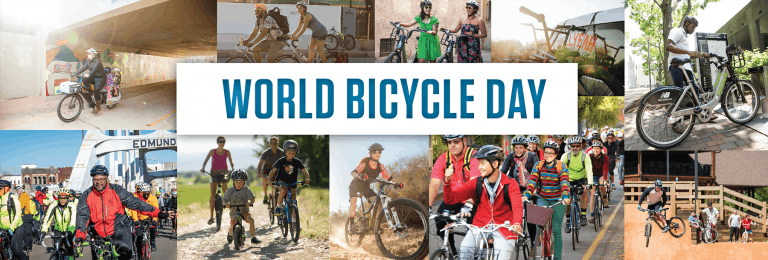Celebrating The Rise of Bicycling
By: PeopleForBikes Staff

Due to the constantly changing dimensions of the COVID-19 crisis, we encourage you to follow all current CDC guidelines as well as local travel advisories and recommendations. Take care of yourselves and loved ones. We’re all in this together.
Today, June 3, is World Bicycle Day — a timely opportunity to celebrate bicycling’s increasing relevance and widespread growth. It’s a great day to ride a bike!
In the U.S. alone, close to 10 million people will pedal today. Many are absolute newcomers to cycling and others are returning to the saddle after years or even decades away. Nearly all will enjoy great experiences and get to where they need to go.
2020 will likely stand as the biggest year for U.S. bicycling since 1973. Sales — particularly of low-cost bikes, e-bikes and kids models – should approach all-time annual highs. Riding participation may break all records, increasing by 20 percent or more in just about every category, on pavement, on dirt, at parks and hopefully (soon) to work and school. Given that Americans traditionally take nearly five billion bike trips a year, this rise is significant.
Lifestyle changes imposed by COVID-19 have been a huge factor in this growth. The pandemic has inspired millions of Americans to reassess what’s important and ask themselves how they want to live. In a sea of bad news and unprecedented challenges, this is a good thing. A new concept of modern living is taking shape. It’s slower paced, more focused on people and simple pleasures, and better for the planet. Bike riding is a growing part of it.
Bike riding checks so many boxes. For short trips, it’s one of the easiest ways to advance from point A to point B. Bicycling contributes to physical and mental health. It’s fun. It’s inexpensive. It helps reduce air pollution, road congestion and climate change. All of these assets make bike riding a contemporary solution.
Finding a Place in the Modern World
Despite all these positives, the simple truth is that bike riding has struggled to maintain its place in an increasingly crowded, high-tech world. In 1973, American drove 1.28 trillion miles in cars and trucks. In 2017, the total was 3.2 trillion — an increase of nearly two trillion miles on an annual basis. During this same period, the U.S. population grew from 212 million to 325 million people: that’s 113 million more people fighting for their piece of the same space.
More people and more crowded roads everywhere: these trends haven’t been good for bicycling. Fewer parents have allowed their kids to ride, unsupervised, on streets. Distracted driving that’s fueled by the omnipresent cell phone hasn’t helped.
Bicycling has also suffered from an image problem. For sure, our car culture has fostered the idea that roads are designated for the exclusive use of cars and trucks and that people on bikes and foot don’t belong. Resistance to bikes has been fueled by an impression that riders don’t follow the rules. Too many Americans view cycling as a strange fringe activity. Tension on roads everywhere seems to have increased.
What’s Around the Bend
But now, we seem to be turning the corner in a big way. It’s easier to imagine a future where bicycling is central and helpful in our daily lives. The rise has begun!
A recent poll of 1,000 Americans concluded that 50 percent plan to ride bikes more often post-pandemic.
While organized children’s sports programs have been on hold, millions of kids have enjoyed their first bike rides. Many are likely to continue when restrictions end; some will ride their entire lives.
Family cycling has grown everywhere. Chances are good that you’ve seen this wherever you live. Bike riding is one of few outdoor activities that parents and kids can do together that’s safe, close to home and maintains social distance. People are having great two-wheel experiences and they’ll seek them forever.
City leaders coast to coast have been decisively reallocating street space to encourage people to bike and walk. While many of these alterations are temporary, some will remain in place for years to come. Independent of these quick fixes, thousands of miles of new bike lanes, paths and trails are being built in cities and on public lands. Transportation and recreation choices are being prioritized. Complete, seamless bike networks will support that goal.
Going forward, financially strapped cities will need to rely on inexpensive solutions. They won’t have the money to build new transit and new roads. Bus, train and subway use is sure to suffer, at least in the short term, as people try to avoid crowded spaces. As bike trips increase, they’ll contribute to tangible reductions in road congestion and air pollution and they’ll deliver the metrics that city leaders value.
This year, nearly one in three Americans will ride a bike. This is a resurgence. Bicycling is becoming more mainstream, more popular and more important as a timely solution to daunting societal challenges. These are just a few of the many reasons to celebrate World Bicycle Day.
